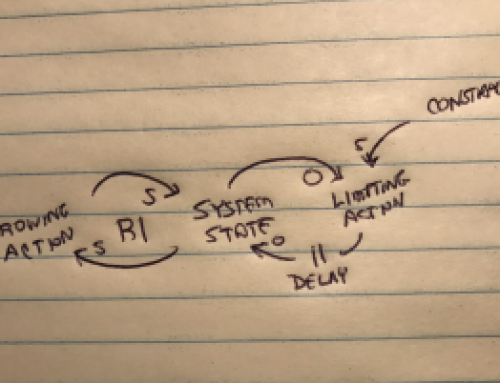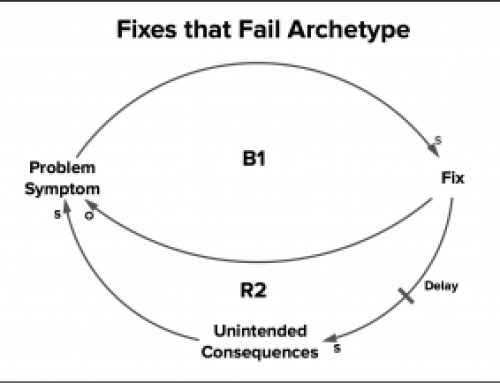One very clear and dominant resistance (whether passive or active) present in all of us, both to change and innovative thinking, are ingrained and accepted ways of doing things or thinking about things that are familiar, comfortable, and just part of us as human beings. The most popular author to write about this is perhaps Peter Senge, who in his book, The Fifth Discipline, labeled the condition I describe as “mental models.” He defines mental models as “deeply held internal images of how the world works, images that limit us to familiar ways of thinking and acting. Chris Agyris, author of various works on the learning organization, discusses this concept of mental models as “theories-in-use” vs. “espoused theories,” where “theories-in-use” represent what people actually do (or think) and “espoused theories” are what people say they want to do or think. Either approach gets to the heart of this very important element in a quest to raise your competitive thinking both as an individual and group. In order to truly think in a competitive and innovative way, open to exploring new ideas, models, and learning, one must first recognize and manage any mental models that are currently at work and, undoubtedly, influencing one’s thinking.
A Closer Look at Mental Models
How can you recognize your mental models? Since mental models only cause issues when they become implicit to our view of the world – meaning, when we are truly not aware they are shaping our view – this present a real challenge. Before addressing that question, a good place to start is to expand a bit on what mental models might look like.
Mental models can be very simple mindsets like assumptions or generalizations. A very stark example of these types of mental models are found in bigotry. Bigots generally hold specific assumptions and generalizations that are simply not true. Yes, there are certainly other sad factors at work, but these generalizations are actually believed as facts and shape the way a bigot thinks at every turn. Another example is the mental model that many possess that makes them distrustful of other people. This is a generalization that goes something like “people are not good at heart and should not be trusted.” This specifically influences how this person acts around other people and how they speak to others.
In business, there can be many simple generalizations that can easily become implicit mental models. Examples of generalizations in business might be things like, “All of our customers love our products”, “Our customers care more about the reliability and durability of our product than they do about price”, “My boss does not care about my views or how this affects me”, and “Our competitors have weak products and are not a threat”. Those are simple things, but hopefully examples of the types of generalizations that could prove harmful if they become implicit in shaping actions and thinking and go unchallenged.
Mental models can also be more complex ideas. In business, these may take the form of accepted processes and routines that have become ingrained deeply and are now simply accepted implicitly. Consider the widely known difficulties of implementing a new Customer Relationship Management (CRM) tool for a group of sales people. Just try that and you will uncover strong mental models about how there is no need for a new tool, how the old way worked just fine, and how this is just a tool to give management more control! Yes, you will suddenly find that many sales people have a hard time overcoming those mental models to embrace new routines, new reasons for doing things in new ways, and to find the true new value in this CRM application.
Recognizing Mental Models
With this knowledge that mental models may be generalizations or more complex ingrained routines or ways of seeing your world, let’s return to the question of how you can work to identify and recognize them. I would suggest that you work at two levels on identifying your mental models.
Reflection on Individual Mental Models
As a starting point, take two sheets of paper out. On one write “Personal Mental Models” and on the second write “Professional Mental Models.” Then, on the first sheet of paper just start writing down what you as a person generally believe about life, your spouse or partner, your children, people in general, your talents, etc. Just write “I believe… sentences. The point is not that you can possibly write down everything you believe, but that you practice identifying things you believe. This raises your level of awareness in terms of generalizations that you implicitly believe, assumptions you make in the world around you. The goal is to personally become more mindful of your assumptions and generalizations to be “real” and also to have opportunity to challenge yourself and grow and expand your views.
On the second sheet (Professional Mental Models) reflect on and write what you believe about your professional self and environment. Focus on what you believe about your professional skills, your strengths, your weaknesses (yes, you believe something about your weaknesses), your fears, your boss, your workgroup, your CEO, your company culture, the way you do your tasks (are your frustrated regularly with the same things), etc. It is vital that you be aware of the implicit mental models that you walk into work with every day. These influence meetings with other individuals. These influence your attitude. These influence how you act.
Reflection on Business Mental Models
The next models to seek to recognize would be the general business mental models that influence your ability to contribute competitive and innovative thinking to business challenges and opportunities. In this case, it is likely not fruitful to attempt to identify these in pure reflection without context. The key here is to consciously ask yourself what mental models you are holding and believing when in a specific business meeting that concerns solving a problem, finding new opportunity, brainstorming, etc., and be willing to share those with the group.
Managing Mental Models
What about going beyond personal recognition and actually managing mental models in a business setting to unleash far more powerful thinking and innovation? That is a tall order and one that lies at the heart of building a learning organization. Traditionally, leadership in organizations tends to think of leadership and management as organizing (people, structures, and systems), managing, and of course controlling. This traditional view leads to a lot of top-down activity and likely fails to create the kind of environment where mental models are openly discussed and challenged throughout the organization. Today, some organizations are much flatter with less hierarchy (restructuring to reduce costs, etc.), but yet, some of the traditional “management” approaches still prevail and thwart true openness. Organizations that are best positioned to enthusiastically embrace the management of mental models must replace traditional the manage-control, authoritarian approach with one that seeks to align vision, values that are spoken and walked very day, and true openness to dialog and challenge of ideas. In other words, business leaders that are more willing to share a vision, embrace common values with employees (and hire to their values), and then allow more engagement in the strategy and thinking process will more likely be able to effectively manage mental models.
What are some tools that are useful in managing mental models? Senge writes about four core tools that assist us in managing mental models:
- Clearly facing the truth relating to our espoused theories vs. our theories-in-use. In other words, in each situation making sure we address things we way vs. things we do (individual or group activity).
- Admitting when we make “leaps of abstraction” (be conscious of moving from true observation about events, facts, etc., to a place where you are just making generalizations with no challenge of those generalizations).
- Articulating what needs to be said (things that we hesitate to say for fear of judgment or perhaps fear of making someone else uncomfortable). Some things left unsaid truly weaken the power of collaborative thinking.
- Balancing inquiry vs. advocacy. It is easy to advocate for a position. It is important to balance that equally with seeking input, seeking new ideas, and asking what others advocate. Balance your use of advocacy (promoting your position) and inquiry (asking what others think and believe).
Of course, as mentioned above, these kinds of activities likely do not occur in environments where a traditional authoritarian culture is at work. It is important for you as a leader to make a conscious decision to begin managing mental models, but you must commit to an approach that includes:
- Clearly communicate to your direct reports that you desire complete equality in brainstorming, sharing of new ideas or solutions, and the process of decision making as far as discussion goes.
- Clearly demonstrate through your actions that it is safe to challenge ideas, even your ideas, and that you expect the same behavior from those direct reports in their own smaller groups.
- Explain the concept of mental models to your group(s)
- Let everyone know that each of you may get defensive about their beliefs, and that the purpose is solely one of improving the overall way each and the group thinks together – this is not an attack on any views
- When working with your group on ideas, expect them to work to clarify their own mental models that might be influencing them, challenge those models, and identify your own and ask that others challenge yours.
- Learn effective dialog leadership skills to promote discussion.
- Reward or celebrate “thinking”, not just successful results.
These very basic steps will put you on the road to having healthy discussions about mental models and actually uncovering and dealing with mental models that may be blocking or inhibiting the thinking power of your group(s). This is a case where my writings or some book may be able to further explain some of the nuances, but the real value is simply in having real conversations with people that practice sharing and managing mental models. This is not rocket science. This is just making sure we don’t keep believing something and living something that needs challenge and new thinking.

